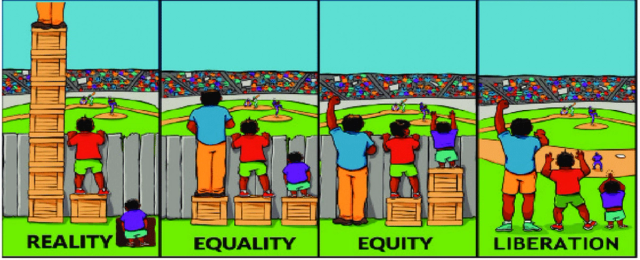Equity in Education

A true equity of access policy must target and support those students who have the most difficulty in accessing post-secondary education (PSE) and give them the support they need to fully participate and succeed in PSE and eventually the labour market.
An equity approach in education means creating the conditions that allow all students to reach their full potential. Equity is not the same as equality or equal access; rather it addresses structural imbalances that keep many from fair and just experiences.
The image below allows us to compare several terms. First, the reality is that members of various groups experience differing access based on their social identities. Second, the notion of equal treatment does not change reality. Third, an equity approach creates options so that people with different experiences will have what they need for access. And of course, the last slide depicts the ultimate goal: a future with no barriers at all.

The Honourable David Onley in his third legislative review of the Accessibility for Ontarians with Disabilities Act, 2005 (2019) noted that Ontarians with disabilities continue to face “soul crushing barriers.” The report discusses the ways that persons with disabilities are often considered as an afterthought in educational policies and budgetary decisions. In Academic Ableism, Jay Dolmage notes the ways that the retrofit approach by educational institutions for students with disabilities results in exclusion “not just from campus space, but from the entirety of collegiate history and lore […] like eugenic design, a retrofit can be meant not to fit a need, but to make its user perform and behave in a particular way, often in a constrained way” (Dolmage, 2017).
Simply the right to attend school is just the beginning for most learners. Considerable research makes clear that racialized “first-generation students, LGBTQ2S+ students, Indigenous students, and students with disabilities are much more likely to decide not to pursue higher education early in middle and high school, believing that post-secondary is simply not for them" (HEQCO, 2019, p. 12). Counsellors and teachers continue to relay such messages to, especially, Black and Indigenous students, and the high rate of expelled and suspended racialized students, especially boys, in high school is a strong determinant of who goes on to postsecondary education.
UDL is one way to think about dismantling inequitable practices in educational design and implementation. Anti-oppressive practices and frameworks offer a deeper consideration of the underpinnings and lived experiences of inequity.